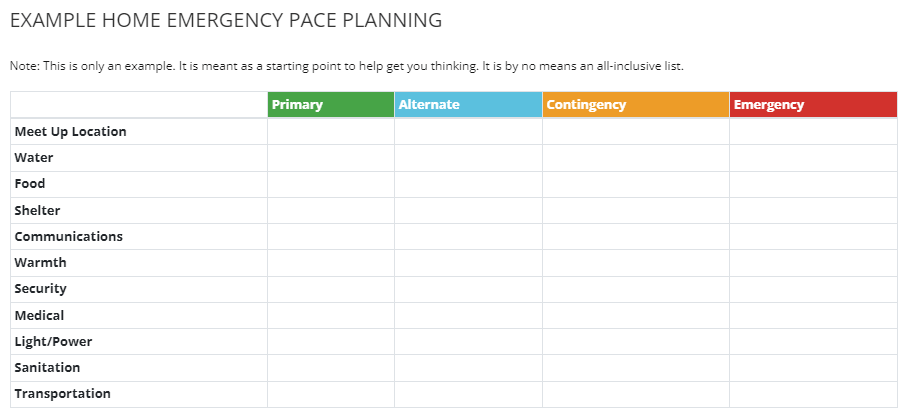Create Your Emergency Preparedness Plan
Author: Iron Survival staff
Plan & Prepare for an Emergency BEFORE Disaster Strikes
You don't have to be a "doomsday prepper" preparing for the end of the world (unless you want to be), but you should at the very least have basic, practical emergency preparations to help get you and your loved ones through most emergencies or natural disasters.
Help isn't coming. You must be prepared to be on your own...
"FEMA is broke. The system is broken. If this is the new normal, Americans can't rely on a federal cavalry when disaster strikes. They will have to take care of themselves."
Brock Long, FEMA Administrator
Emergencies and disasters come in all shapes and sizes, and usually without warning. Having peace of mind knowing that you are prepared to provide for yourself and your loved ones can eliminate a lot of stress and worry in an already stressful, and potentially life threatening, situation.
There are endless ways "IT" can hit the fan. IT can be local, regional, national or global. IT might be a devastating earthquake or storm, an EMP strike or CME (Coronal Mass Ejection) that takes down the power grid, a deadly global pandemic, an economic collapse, a critical long term food shortage, or even World War 3.
You may have noticed that some of these suddenly don't seem so far out of the realm of possibility.
"IT" can also be less dramatic. IT may only affect you and your family, but still be devastating - such as an unexpected job loss, business failure, automobile accident or illness, or the death of a spouse.
Regardless of what IT is, when IT hits, you and your family will be grateful that you planned and prepared ahead of time.
There are endless ways "IT" can hit the fan. IT can be local, regional, national or global. IT might be a devastating earthquake or storm, an EMP strike or CME (Coronal Mass Ejection) that takes down the power grid, a deadly global pandemic, an economic collapse, a critical long term food shortage, or even World War 3.
You may have noticed that some of these suddenly don't seem so far out of the realm of possibility.
"IT" can also be less dramatic. IT may only affect you and your family, but still be devastating - such as an unexpected job loss, business failure, automobile accident or illness, or the death of a spouse.
Regardless of what IT is, when IT hits, you and your family will be grateful that you planned and prepared ahead of time.
Assess Your Emergency Preparedness & Make a Plan
The old saying "If you fail to plan, you plan to fail" is particularly true in emergency and survival situations, where failure can mean the death of yourself and/or your loved ones.
At Iron Survival, we want to help you to understand and plan for the key areas of emergency preparedness, and to assess your strengths, weaknesses, and areas of improvement.
At Iron Survival, we want to help you to understand and plan for the key areas of emergency preparedness, and to assess your strengths, weaknesses, and areas of improvement.
Home Emergency Preparedness PACE Planning
In helping you to understand and establish your home emergency preparedness plan, we also want to help you understand and conduct your PACE planning.
PACE planning is a military planning concept that has been borrowed by many areas of civilian life, most notably by preppers, and for good reason. It is a simple acronym for a critical concept that helps you identify and plan for multiple options based on different, changing or worsening circumstances.
P is your Primary option.
A is your Alternate option.
C is your Contingency option.
E is your Emergency option.
This provides depth and redundancy in your planning and available choices, as Murphy's Law will always apply in a disaster or emergency, and you will likely find yourself requiring additional options when things go from bad to worse.
Rather than panic and lose precious life-saving time because something foiled your plan, or worse - being without any options - you can quickly switch to "Plan B", or C, or D.
To illustrate this at a basic level, consider that part of your planning may be how you would plan to get home from your place of work across town in an emergency. For this illustration, let's say there was a large earthquake:
PACE planning is a military planning concept that has been borrowed by many areas of civilian life, most notably by preppers, and for good reason. It is a simple acronym for a critical concept that helps you identify and plan for multiple options based on different, changing or worsening circumstances.
P is your Primary option.
A is your Alternate option.
C is your Contingency option.
E is your Emergency option.
This provides depth and redundancy in your planning and available choices, as Murphy's Law will always apply in a disaster or emergency, and you will likely find yourself requiring additional options when things go from bad to worse.
Rather than panic and lose precious life-saving time because something foiled your plan, or worse - being without any options - you can quickly switch to "Plan B", or C, or D.
To illustrate this at a basic level, consider that part of your planning may be how you would plan to get home from your place of work across town in an emergency. For this illustration, let's say there was a large earthquake:
Primary
Your Primary option to get home naturally would be your regular vehicle, taking a special pre-determined route to avoid major traffic snarls. If your vehicle is not functioning or available (it was in a parking garage that collapsed during the earthquake)...
Alternate
Your Alternate option might be a bus or other public transit. You already planned ahead and know the routes. If that were shut down or unavailable (the earthquake knocked out power across town)...
Contingency
Your Contingency option might be to commandeer a bicycle (no stealing - be sure to return it later!)...
Emergency
And, last but not least, when everything else fails your Emergency option might be to walk home (time to renew that gym membership).
A simplified scenario, but you get the idea.
Your Primary option to get home naturally would be your regular vehicle, taking a special pre-determined route to avoid major traffic snarls. If your vehicle is not functioning or available (it was in a parking garage that collapsed during the earthquake)...
Alternate
Your Alternate option might be a bus or other public transit. You already planned ahead and know the routes. If that were shut down or unavailable (the earthquake knocked out power across town)...
Contingency
Your Contingency option might be to commandeer a bicycle (no stealing - be sure to return it later!)...
Emergency
And, last but not least, when everything else fails your Emergency option might be to walk home (time to renew that gym membership).
A simplified scenario, but you get the idea.
You should conduct the same type of PACE planning in each of the key areas of emergency preparedness. Begin with establishing or securing at least a Primary method or option in every key area, so that your main bases are covered. Then, as you are able, begin to add a second Alternate set of options. Then a third Contingency set, and so on. You may find that you already have some areas well covered in depth, but have critical gaps in several others.
For example:
For example:
-
Do we have food?
-
How will we cook meals or acquire safe drinking water?
-
How many ways can we provide light or power if the electricity goes out?
-
How can we safely heat our home or stay warm?
-
Where will we go if our home is uninhabitable or we can't stay here?
-
How will we travel and bring the items we need to survive?
-
How will we communicate with loved ones and where will we meet?
-
How will we will get news and important emergency information?
-
How will we care for our family's injuries or medical needs?
-
How can we safely handle bathroom needs and sanitation?
-
How will we buy or barter for things we might need?
-
How will we get the kids if it happens during school or when they are away from home?
-
How will we protect ourselves and do we know how?
-
etc. etc. etc.

This is only scratching the surface. Yes, it can take some time and thought, and you may need to purchase some items, but isn't your life and the lives of your family worth it? The piece of mind you obtain in the process is beyond measure.
Make a Plan, then Communicate It, Test it, Practice It & Refine It
Once you have a plan, practice it, test it out, and refine it to work the bugs out. When disaster strikes, your planning and preparations may very well save your life and that of your family.
Just having a plan isn't enough - it is critical that every member of your family knows and understands the plan in advance. You can also "war game" scenarios with your family to help you improve your plan. "If X happens, then we'll need Y."
Be careful not to go overboard, as it's impossible to prepare for every possible contingency. If you have good emergency preparedness supplies, a solid plan, and good common sense, it will see you safely through the majority of emergencies that can be reasonably prepared for, and provide a basis from which to work for those you couldn't.
Remember: The time to identify and address the critical gaps in your emergency preparedness, and to plan, practice and refine your plan, is before an emergency or disaster happens.
When you have a plan and multiple options, you are far less likely to panic, and much more likely to survive, in an emergency.
Iron Survival and our coaches & instructors stand ready to assist you in your emergency preparedness planning and preparations.
Just having a plan isn't enough - it is critical that every member of your family knows and understands the plan in advance. You can also "war game" scenarios with your family to help you improve your plan. "If X happens, then we'll need Y."
Be careful not to go overboard, as it's impossible to prepare for every possible contingency. If you have good emergency preparedness supplies, a solid plan, and good common sense, it will see you safely through the majority of emergencies that can be reasonably prepared for, and provide a basis from which to work for those you couldn't.
Remember: The time to identify and address the critical gaps in your emergency preparedness, and to plan, practice and refine your plan, is before an emergency or disaster happens.
When you have a plan and multiple options, you are far less likely to panic, and much more likely to survive, in an emergency.
Iron Survival and our coaches & instructors stand ready to assist you in your emergency preparedness planning and preparations.
©Copyright Iron Survival, LLC. All rights reserved.
Write your awesome label here.
Join the Iron Survival community
Stay sharp & informed with the latest news, training updates and expert articles from our elite instructors
Iron Survival, LLC
Featured links
Policy Pages
©Copyright 2026 Iron Survival, LLC
